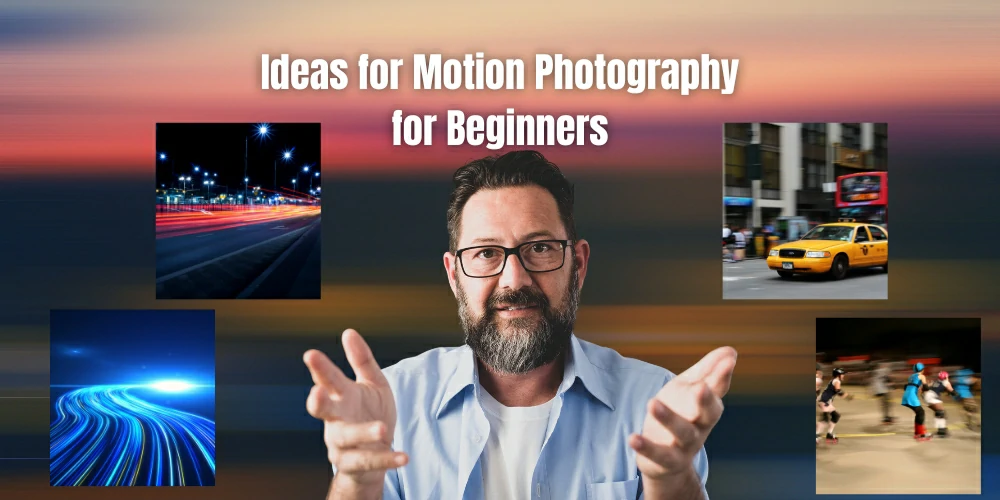Unique and Creative Ideas for Motion Photography

In the realm of photography, capturing motion is an art form that transcends still imagery. It breathes life into moments, creating a dynamic visual narrative. To master the art of motion photography, one must delve into a repertoire of creative ideas. Here, we present a comprehensive guide brimming with inspiration and techniques to elevate your motion photography endeavours.
Ideas for Motion Photography
Contents

Freezing Action
In motion photography, freezing action is akin to capturing a split second that tells a compelling story. Whether it’s a dancer mid-leap or a sportsman in the heat of the game, mastering this technique requires impeccable timing and a keen eye.
The Dance of Light and Shadow
Light and shadow are the quintessential elements of photography, but in motion photography, they take on a mesmerizing new dimension. Experimenting with the interplay between light and shadow can yield stunning results, creating depth and drama in your shots.
Panning
Panning involves tracking a moving subject while using a slow shutter speed. This technique allows you to maintain focus on the subject while blurring the background, conveying a sense of dynamic motion. It’s perfect for capturing subjects like cyclists, runners, or wildlife in action.
Long Exposure Magic
Long-exposure photography is a gateway to a surreal world of motion by leaving the shutter open for an extended period, moving elements in the frame blur, creating a dreamlike quality. This technique is particularly effective when photographing flowing water, traffic trails, or starry skies.
Zoom Burst
Zoom burst is a dynamic technique that involves adjusting the focal length of your lens while the shutter is open. The result is a visually striking image with a burst of energy emanating from the subject. It’s a powerful way to convey motion in a single frame.
Kinetic Sculptures
Exploring the world of kinetic sculptures opens up a realm of possibilities for motion photography. These mesmerizing creations are designed to move, creating captivating patterns and shapes that make for compelling visual subjects.
Underwater Elegance
Taking motion photography beneath the waves introduces a mesmerizing world of fluidity and grace. From the dance of aquatic life to the gentle sway of seaweed, underwater motion photography offers a unique canvas for creative expression.
Creative Ideas for Motion Photography

Motion Trails
Capture the essence of motion by photographing moving objects in low-light conditions. The result? Striking trails of light that add a touch of magic to your images. This technique is especially effective in urban settings with passing cars or in natural settings with fireflies.
Levitation Photography
Elevate your motion photography to new heights with levitation techniques. By cleverly positioning your subject and employing basic editing skills, you can create the illusion of weightlessness, adding a surreal and whimsical touch to your images.
Ideas for Motion Photography for Beginners

Smartphone Slow-Mo
For beginners, diving into motion photography can be as simple as using your smartphone’s slow-motion feature. It’s an accessible way to experiment with capturing motion, allowing you to observe and understand the nuances of movement.
Time-Lapse Wonders
Time-lapse photography is a beginner-friendly avenue to explore motion. Set up your camera to capture a sequence of images over time and witness the world in fast-forward. It’s a fascinating way to document change and movement in various scenarios.
Fun with Props
Introduce props into your motion photography to inject an element of playfulness. From balloons caught mid-air to twirling ribbons, props can create dynamic and eye-catching compositions that tell a lively story.
Fantastic Ideas for Motion Photography

Smoke Trails
Experiment with capturing the graceful swirls of smoke in motion. This technique lends an air of mystique to your images, creating a visually captivating experience. With the proper lighting and composition, you can achieve stunning results.
Water Splash: Dynamic Eruptions
Capture the explosive moment when water collides with an object or surface. Timing is critical, and with practice, you can freeze this dynamic motion, resulting in images that evoke a sense of energy and vitality.
Capturing Motion in Everyday Life

Motion photography isn’t limited to grand events or sports. Everyday scenes can also be rich sources of dynamic imagery. Try capturing a bustling street, children at play, or a busy market. The juxtaposition of still elements with the motion of people and objects can create compelling visual stories.
The Art of Composition in Motion Photography

Beyond freezing action, how you frame your subject in motion is crucial. Experiment with different compositions—rule of thirds, leading lines, and framing techniques. This adds depth and context to your images, enhancing the overall impact.
Exploring Time-Interval Photography

Time-lapse photography allows you to compress extended periods into a short, dynamic sequence. It’s perfect for capturing the transition of day to night, the blooming of a flower, or the movement of clouds. With the proper settings and patience, you can create mesmerizing time-lapse videos.
Motion in Nature: Wildlife Photography

Nature provides a wealth of opportunities for capturing motion. Whether it’s a bird in flight, a galloping herd, or a cascading waterfall, wildlife photography is a thrilling pursuit. Patience, knowledge of animal behaviour, and quick reflexes are crucial to success in this genre.
Mastering Motion with Flash Photography

Integrating flash into your motion photography can yield striking results. Synchronize the flash with your camera’s shutter speed. It will freeze action shots while still capturing ambient light. This technique is especially effective in low-light conditions or for creating dramatic, high-contrast images.
FAQs (Frequently Asked Questions)
How do I choose the correct shutter speed for motion photography?
Selecting the appropriate shutter speed depends on the speed of the subject and the desired effect. Experiment with different settings to achieve the desired level of motion blur.
What equipment is essential for motion photography?
A camera with manual settings, a selection of lenses, a sturdy tripod, and an understanding of basic exposure principles are essential to successful motion photography.
Can I achieve great motion photography with a smartphone?
While smartphones have advanced in their photography capabilities, dedicated cameras with manual settings offer greater control over motion photography techniques.
What are some tips for capturing motion in low-light conditions?
In low light, use a tripod to stabilize the camera and opt for a higher ISO setting to maintain a faster shutter speed. Consider using external lighting sources for added illumination.
How can I convey a sense of speed in my motion photographs?
To convey speed, experiment with techniques like panning and long exposure. These methods create dynamic blur effects that suggest rapid motion.
What post-processing techniques enhance motion photography?
Adjusting contrast saturation and applying selective sharpening can accentuate the dynamic qualities of motion photography during post-processing.
Final Words
Embarking on the journey of motion photography opens doors to a world of endless creativity. By employing these ideas and techniques, you’ll unlock the potential to capture dynamic moments that resonate with viewers. Let your imagination run wild, and watch as your motion photography soars to new heights.






